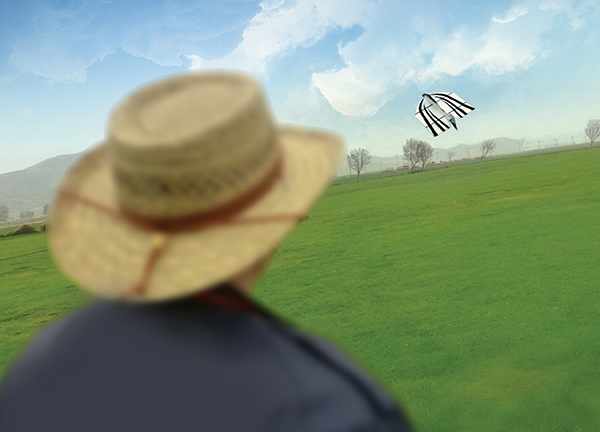Xstream

Simplicity and versatility in foam Article, photos, and design by Charles Mackey Read the full article in the June 2014 issue of Model Aviation.
The X-Stream is the fourth in the series of “X” designs. All were successful and unusual, but the X-Stream was different because it was a complete break from the first three in order to test the The wing area of a typical small foam design was doubled and used as the amount of side area for the X-Stream. The Mean Aerodynamic Chord (MAC) or 25% of the side area was put on the wing’s CG. The control surfaces were doubled in area from what would normally be used. To balance the airplane, it was necessary to move everything forward in order to use pull-pull controls. Thanks its twin I-beam construction, it was unnecessary to use external bracing. The design goal was to make a flying wing with good knife-edge qualities and a wide range of controllable speeds—especially for slow flying. If you are new to scratch-built foam airplanes, I’ll share a few tips. First cut out all of the parts. Glue the two .008 carbon-fiber strips that form half of the I-beam in place as shown on the plans. After they are dry, turn them over and place them on a flat surface. Now glue on the two layers of 3mm foam around the edges of the airplane and in the I-beam area. Next glue on the other two strips of carbon fiber to complete the two I-beams. Now complete the bottom of airplane as far as you can. That would include the fuselage bottom, epoxying the three servos in place, and adding the foam 45°-angle brace on one side as shown on the plans. Next add the .008 x 1/4-inch X carbon-fiber strip that runs from the motor mount to the high point of the fuselage bottom. The next step is important. You need a way of support the airplane while you complete the top half. In the past, I had used similar-size full cans of food from the pantry, but it was frustrating. I solved this problem by using six pieces of 2 x 6 dry wood that had been squared on a table saw and checked to be true. My friend, Ron Hudson, uses cement blocks for this purpose and he is happy with his method. Do you have some new ideas?

The X-stream (center) is the fourth of the X series that includes X-Files (R), X-File II, and Half X (L).

The author used a Turnigy 2204 motor, Castle Creations Thunderbird 9 ESC, Berg 4 receiver, and three Hextronic HTX500 servos. He used a 3S 370 mAh battery.
The Pull-Pull Control System
Long control horns and servo arms will ensure that any unwanted play in the system will be negated. Avoid short control arms. I extend my servo arms with 1mm diameter carbon-fiber rods that are 3 inches in length. Cut a slot in the servo arm to fit the rod. It doesn’t need to be centered, but leave enough room for the servo screw. Bind the arm to the rod with thread or small soft wire and then fill in any gaps with epoxy. Install the radio equipment and control horns. Now is the time to set up your control surfaces and trims. Turn on the transmitter and install the servo horns as close to perpendicular to the foam surfaces as possible. Now use your subtrim or centering to make final adjustments. When the alignment is correct, turn the transmitter off and lock the servo arms in neutral with scrap foam and masking tape. You are now ready to install the pull-pull lines. Attach the lines to the servo arm ends with a slip knot, tighten, and glue it in place. I use vinyl tubing and hot glue on control horns to make them adjustable. Lock the elevator and rudder in neutral. Cut six pieces of vinyl tubing approximately 3/8 inch long. Working on one servo at a time, feed the lines through the tubing and place it over the rod ends. Pull both the lines tight and glue with hot glue. They do not need to be as tight as a guitar string, merely tight enough to remain straight. If you ever need adjust your controls, touch the tip of your hot glue gun to the tubing, adjust the line, and reglue it.Choosing Your Motor
I started with a 2208-14T Turnigy motor with a 3S 400 to 500 mAh battery and turning an 8 x 4.3 SF propeller and it worked well until I burned up the motor with the large propeller. Next I tried an AXI 2208/34 and it did well with a 9-inch propeller on a 3S LiPo. I now have a Hacker A20-34S with a 3S LiPo and a 9 x 4.7 propeller and I am happy with that. The most important thing is to maintain the balance point on the front I-beam by relocating the battery.Flying
I have a few words about flying foam airplanes. I started designing aerobatic airplanes in 1946 and I believe that foam airplanes are the best thing that has ever happened for those of us who love this type of flying. These airplanes are inexpensive, quiet, simple to build, and I have no fear of flying them. Their other benefits include being easy to repair and capable of flying in a wide range of areas. You can fly in a gymnasium or soar with the eagles in the sky. When you develop your flying skills, you can take off on windy days when those with big, expensive airplanes are unwilling to take that risk and are packing up. You can put on a windy-weather demonstration by flying backward, doing knife-edge hovering and rolls only a few feet away from yourself, and make spot landings at your feet. You will learn to regard the wind as a friend. Now that is fun! I have a pleasant wish to send to you: I hope you enjoy your first flight as much as I did mine.


 |  |










2 comments
I really like and want to do
X-stream
Add new comment